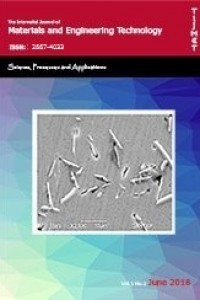PROPERTIES OF KNITTED FABRICS PRODUCED WITH VORTEX SPINNING PRINCIPLE OF REGENERATED CELLULOSE FIBERS
PROPERTIES OF KNITTED FABRICS PRODUCED WITH VORTEX SPINNING PRINCIPLE OF REGENERATED CELLULOSE FIBERS
regenerated cellulosic fiber, vortex spun yarn,
___
- References1. RÖDER, Thomas, et al. Comparative characterisation of man-made regenerated cellulose fibres. Lenzinger Berichte, 2009, 87: 98-105.
- 2. Majumdar, A., Mukhopadhyay, S., Yadav, R. (2010). Thermal properties of knitted fabrics made from cotton and regenerated bamboo cellulosic fibres. International Journal of Thermal Sciences, 49.10: 2042-2048.
- 3. SUNDARESAN, S., et al. Study on the Characteristics of Fabric Made From Air Vortex Viscose Rayon Yarn. International Journal on Textile Engineering and Processes ISSN 2395-3578 Vol. 3, Issue 2 April 2017)
- 4. Rameshkumar C., Anandkumar P. , Senthilnathan P., Jeevitha R., Anbumani N. AUTEX Research Journal, Vol. 8, No4, December 2008, Comparitive Studies On Ring Rotor And Vortex Yarn Knitted Fabrics
- 5. Günaydın, G.K., 2011. Murata Vorteks İplik Eğirme Sisteminde İplik Eğirme Düzesinin Özelliklerinin ve Konstrüksiyon Yapısınının İplik Parametrelerine Etkilerinin Araştırılması. Süleyman Demirel Üniversitesi Fen Bilimleri Enstitüsü, Doktora Tezi, 275s, Isparta.
- 6. Basal G. (2003). The structure and properties of Vortex and Compact spun yarns. Dissertation. Faculty of North Carolina State University, Raleigh. Retrieved 2013, 5, 12, Web site: http://repository.lib.ncsu.edu/ir/handle/1840.16/4631
- 7. Basal, G., Oxenham, W. (2003). Vortex Yarn vs. Air-Jet Yarn. AUTEX Research Journal, 3(3), 96-101.
- 8. Soe, A. K., Takahashi, M., Nakajima, M. et al. (2004). Structure and properties of MVS yarns in comparison with ring yarns and open-end rotor spun yarns. Textile Research Journal, 74(9), 819 – 826.
- 9. Basal, G., Oxenham, W. (2006). Effects of some process parameters on the structure and properties of Vortex spunyarn. Textile Research Journal, 76 (6), 492-499
- 10. Erdumlu, N., Ozipek, B., Oztuna, A., Cetinkaya, S. (2009). Investigation of Vortex Spun Yarn Properties in Comparison with Conventional Ring and Open-end Rotor Spun Yarns. Textile Research Journal 79 (7), 585-595.)
- 11. Prakash, C.; Ramakrıshnan, G.; Koushık, C. V. Effect of blend proportion on moisture management characteristics of bamboo/cotton knitted fabrics. The Journal of The Textile Institute, 2013, 104.12: 1320-1326.
- 12. Matsudaira M, Yang M, Kinari T, Shintaku S. Polyester ‘Shingosen’ Fabrics Characterized by Dynamic Drape Coefficient with Swinging Motion. Textile Res. J. 2002; 72, 5: 410–416.
- 13. Angappan P, ‘Handbook on Textile Testing’ p 325-330,1997.
- 14. Değirmenci, Z., and Ebru Ç. (2017). The Influences of Loop Length and Raw Material on Bursting Strength Air Permeability and Physical Characteristics of Single Jersey Knitted Fabrics. Journal of Engineered Fibers and Fabrics 12.1. 43-49.
- Yayın Aralığı: Yılda 2 Sayı
- Başlangıç: 2018
- Yayıncı: Necip Fazıl YILMAZ
REMOVAL of DYE POLLUTION by MODIFIED HALLOYSITE as ECO-FRIENDLY ADSORBENT
Züleyha DEĞİRMENCİ, Ebru ÇORUH
EFFECT OF SECONDARY AGING of EN AC 43200 ALUMINUM ALLOY to MECHANICAL PROPERTIES
Bedri BAKSAN, İbrahim ÇELİKYÜREK, Yusuf KILIÇ
INVESTIGATION OF THE BULLET IMPACT ENERGY PERFORMANCE ACCORDING TO VARIABLE TIP GEOMETRY
Murat SUBAŞI, Mehmet Hanifi DOĞRU, Eyüp YETER, Necip Fazıl YILMAZ
